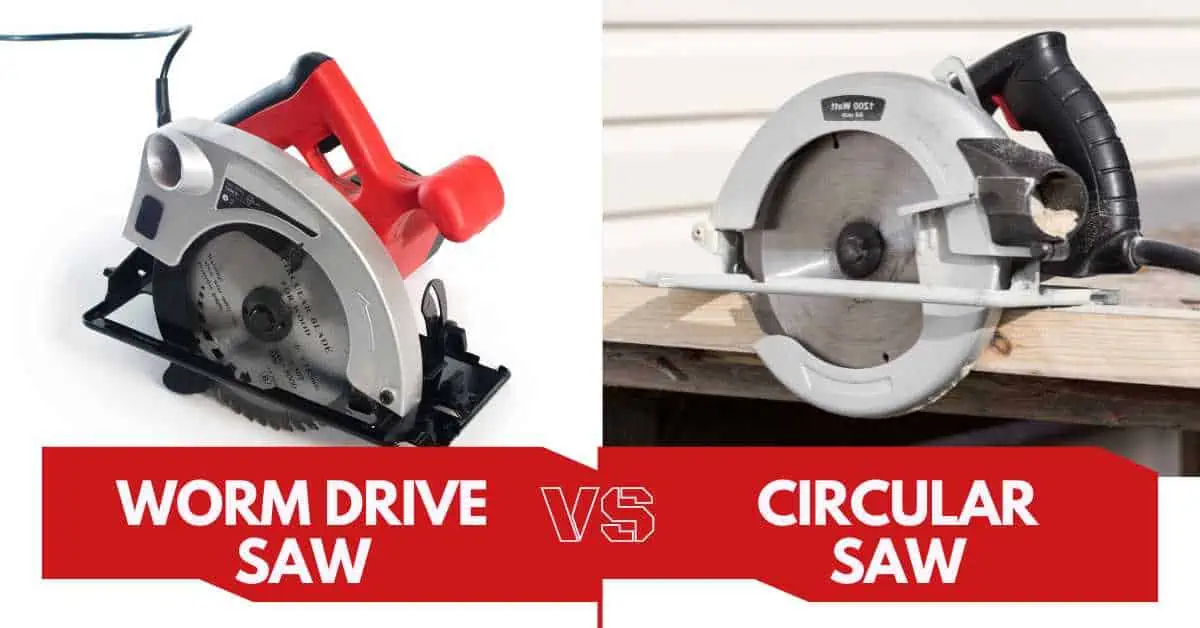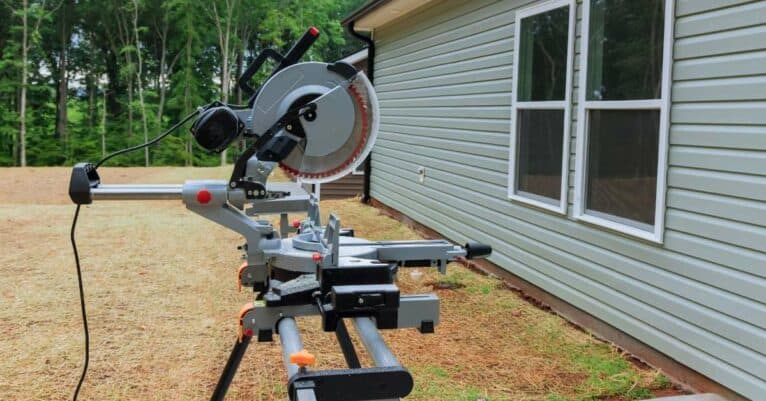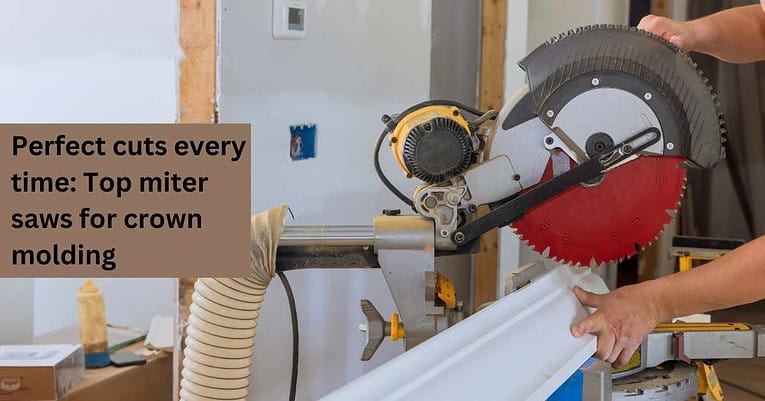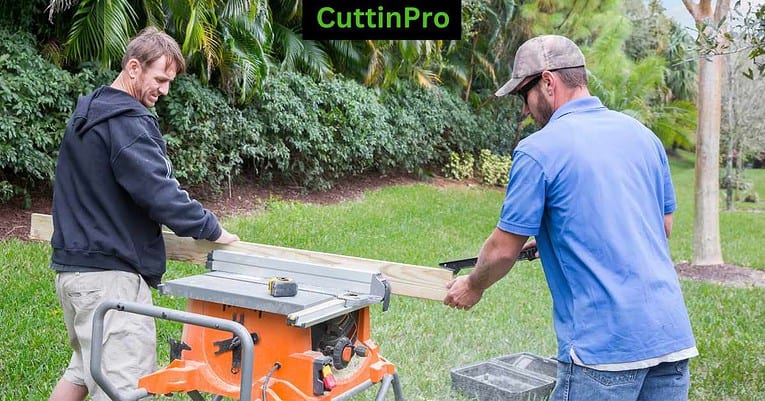Worm Drive Saw vs. Circular Saw – Which Is the Ultimate Cutting Tool?”
Worm Drive Saw vs Circular Saw
When it comes to woodworking, the saw you choose can make or break any project. Whether a hobbyist or professional, selecting the most appropriate tool for each task is critical for proper completion and outcome. With two leading powered saws available to woodworkers -the circular saw and the worm drive saw- both have unique features that either help an individual reach the desired goal quickly or let them down in their tracks. Each has unique performance characteristics based on which particular job demands need to be met and depending on where those saws are operated from will weigh heavily in picking your perfect partner. In this article, we’ll compare each type of power tool when it comes to cutting through different materials like hardwoods, softwoods, cement boards, particle boards, etc. while highlighting potential safety concerns reviewed by users so you can make an educated choice when choosing between these two types of power tools.
Understanding Worm Drive Saws
What is a Worm Drive Saw?
A Worm Drive Saw is a high-powered circular saw designed to tackle jobs that need more power and torque than an ordinary circular saw can provide. It features many of the same components as a regular saw, including a motor, drive shafts, spindle gear, blade guard, and triggering handle. But what makes the worm drive so special is its unique gearing system design. The rear-mounted motor along with specially designed toothed gears rotates both horizontally and vertically in order to create tremendous amounts of torque. This kind of increased force allows it to cut through hardwoods, softwoods, and other difficult materials at much higher speeds than standard saws are usually capable of doing without straining or overworking them. Another advantage this style possess is superior ergonomics; specifically between user comfortability and added control during use thanks to its longer shaft which provides better balance while creating a smoother cutting motion allowing for more precise cuts overall.
Advantages of Worm Drive Saws
Worm drive saws are the go-to choice for professional woodworkers who really need to get in there and tackle heavier and tougher work where standard circular saws may not cut it. There are several advantages of using this type of power tool over a regular circular saw:
- High Torque and Power: The combination of gears and an enclosed motor gives the worm drive saw much more torque when it comes to cutting dense materials such as hardwoods, softwoods, particle boards, cement boards, etc. It is also powerful enough to cut through thicker items like 2x4s with ease.
- Better Handling for Heavy Duty Tasks: Its long shaft helps provide a better balance while creating smoother movements resulting in greater accuracy without straining the operator’s wrists from fatigue after prolonged use.
- Enhanced Cutting Accuracy and Control: Worm drive saws also possess greater speed control settings allowing for better accuracy so jobs that require straight cuts are much easier to achieve.
- Ideal For Rip Cuts and Long Cuts: Its circular blade design is more appropriate for long straight cutting strokes (rips) while still being able to make beveled angled cuts quickly.
- Greater Durability and Longevity: The gears used in worm drive saws last longer than those found on other types of powered tools since they are contained within an enclosed motor preventing wear from wood particles or dust that might otherwise damage it prematurely.
Limitations of Worm Drive Saws
Like any other power tool, worm drive saws have a few drawbacks as well. While their high torque and accurate cuts are great for certain tasks, there are some conditions where they may not be the best choice:
- Heavier and Bulkier Than Other Saw Types: Since the motor is located at the rear of this type of saw it is also bulkier in size making them heavier than standard circular saws which often makes them harder to maneuver or adapt into more tight spaces with ease.
- More Expensive Upfront Cost: This style of saw will typically cost you more upfront but due to its larger capacity for powerful operation, you can save money over time from having to replace cheaper options much sooner.
- Challenging For Overhead Cuts And Tight Spaces: Because these power tools weigh a bit more it can be tricky to successfully execute an overhead cut since they tend to fall back down while trying unless using proper safety gear such as ladders and harnesses. Additionally, due to its larger frame that may prevent getting into smaller surfaces like countertops when needed.
- Steep Learning Curve For Beginners; Another potential con worth mentioning is the steeper learning curve that comes with using a worm drive saw versus your average circular variety-which is ideal for novice woodworkers looking to tackle projects safely and get first-hand experience.
You may also like:
- 5 Best Worm Drive Circular Saws for Every Project
- Ultimate Guide to the Best Circular Saw Blades for Plywood: Top 7 Picks and Reviews
- Miter Saw or Circular Saw: Which One is Best for Your Woodworking Projects?
- Compact Circular Saws for Every Job: Top Picks and Reviews
Exploring Circular Saws
What is a Circular Saw?
A Circular Saw is a power tool designed to make quick and efficient cuts in wood, plastic, or other soft materials. It relies on an electric motor that spins a circular blade around its arbor which slices through whatever material it makes contact with. This type of saw typically features a base plate, blade guard and trigger handle much like the worm drive style but differs from it greatly by its lack of high torque due to the absence of specially-designed gears found on its rival counterpart. Its ergonomics are quite good allowing the user plenty of freedom when pivoting the unit despite not having as good balance as worm drives since most units do possess handles for proper grip stability particularly around tight spaces during use.
Advantages of Circular Saws
Circular saws prove to be a great choice for any type of woodworking job. With its lightweight design it’s much easier to carry around while also being more affordable than other saw types on the market today. Here are several compelling advantages this type of power tool has over its competition:
- Lightweight Design For Easy Mobility: Since circular saws do not rely on gears their weight is significantly reduced making this style far superior in terms of portability and range depending on how you need to use it when tackling tasks.
- Lower Upfront Cost Than Other Saw Types: Due to their simpler construction, these can often cost less which may particularly appeal when considering fit a tight budget or dealing with last-minute projects that require pinching pennies where possible.
- Not As Challenging For Overhead Cutting Jobs: Being lighter, execution overhead jobs due to the decreased amount of exertion required while staying secured until completion without having fear the unit falling down during operation as heavier ones might due to lack of proper grip support.
- Ease Of Use And Lesser Learning Curve: Both professionals and DIYers will find this style easy to use and/or comprehend thanks to its simplistic design. Beginners can pick up a circular saw with greater confidence than trying their luck with a worm drive since the skill requirement is much lower for the same quality cut.
- Greater Speed Accuracy Compared To Hand-Held Saws: Conversely, circular models also prove more proficient when precision is needed due to their created higher powered friction between the cutting blade and material using them which ultimately helps dictate smoother results upon completion versus taking risks using hand-held saws elsewhere.
Limitations of Circular Saws
The same features that make Circular Saws great for certain applications may limit them in other areas. While they are designed to meet the needs of most cutting tasks, there are some limitations of this styling tool that should be factored in when deciding whether or not this is the appropriate saw for a project:
- Less Power and Torque Than Worm Drive Saws: Since these models do not rely on specially-designed gears like their counterparts they lack quite a bit in terms of power and torque which can hinder more vigorous jobs involving hardwoods, particle boards, etc.
- Inability To Make Wide Bevel Cuts On Thick Materials: One of the biggest drawbacks includes its inability to perfect wide angle cuts (over 45°) efficiently without burning material during extended sessions specifically involving harder mediums before needing blade replacement due to heat created from prolonged repeat use.
- Not Ideal For Rip Cuts Without Multiple Blades And Guide Rails: Finally, an interesting con worth mentioning has to do with rip cuts-which require at least two blades attached concurrently along guide rails otherwise two separate setups will be necessary when performing them if you don’t possess either kind nowadays.
Worm Drive Saw vs Circular Saw – Comparing Performance and Functionality
Power and Torque
When it comes to power and torque, worm drive saws outclass their circular saw counterparts. This is mainly due to the design of its motor system along with specially-crafted gears located at the rear which create tremendous amounts of torque when cutting; allowing users to make cuts that a regular saw simply couldn’t dream of achieving without crushing performance due to increased effort or strain placed upon operator after prolonged use. Meanwhile, circulars provide excellent agility but lack the true strength needed for heavier applications like hardwoods or particle boards where they are more suited for lighter duties such as softwoods and plastics, etc.
Cutting Depth and Accuracy
When it comes to depth cutting and accuracy, worm drive saws reign supreme. As mentioned before, its added torque allows users to make deeper cuts through even the toughest of materials with superior precision since their bevel settings are designed for more accurate measurements which helps create a smoother and uniform finish upon completion. Circular saws provide decent accuracy for typical woodworking jobs but as soon as tougher situations arise their limitations are exposed due lack of power needed to overcome them. The plus side here is that these styles typically will cost you less upfront compared to their counterparts if on a tight budget or replacing an existing in-need repair or other service-although they too require replacements from time to time depending on how frequently they have been used.
Weight and Portability
In terms of weight and portability, worm drive saws are bulkier and heavier when compared to its circular style competitor. This is due the extra components found on rear (i.e., gears included in motor system) that incurs added material which makes this type rather awkward carry around at times-especially if tackling several locations in one day or needing store away tightly during non-working hours elsewhere. Circular saws meanwhile offer plenty mobility since do not possess those particular parts which allows for less strain while maneuvering them into whatever position user needs to get job done properly with greater agility than underlying patron can provide making these ideal for expansive outdoor applications where swift movement is prefer led by contractor or hobbyist alike potentially saving considerable amount money time along way as well.
Price and Affordability
The pricing between these two saw types can sometimes determine which one will be the best choice when the budget is an issue. With that said, worm drive saws typically have a higher initial investment compared to circular models but delivers a much better value in terms of long-term efficacy making them suitable for professionals and serious hobbyist alike. Having great torque makes them capable of handling tough material while creating smoother results with greater precision upon completion until wear and tear make it time for replacement once again. Circular saws however provide an affordable platform for almost anyone looking into light-duty do-it-yourself projects or even professional business when needing to carry out different jobs simultaneously without breaking the bank in that sense.
Application and Versatility
When it comes to the application of these two saw types, each one has its own unique strengths as well as limitations. Worm drive saws are best for heavy-duty professional applications and rip cuts involving hardwoods due to their unsurpassed torque while keeping accuracy and control to an optimum level when cutting. Circular saws provide satisfactory performance but lack the strength needed for big jobs making them more suitable for lighter home projects or occasional woodworking tasks found in workshops that may not require powerful tools on a regular basis. Overall both styles are highly versatile performers each serving its own respective purpose depending on which user chooses to apply them towards meeting the end goal whether that be professionally or recreationally resulting in a perfect finish too.
Factors to Consider When Choosing
Before deciding between a worm drive saw or circular saw for a woodworking project, there are four key factors to take into consideration.
- Project requirements: Identifying the specific needs of your woodworking projects will help refine the selection process. Knowing what type and thickness material is being used as well as any specialized tools or sizes cuts needed play an important role in identifying which tool is best suited for the task at hand.
- Experience and skill level: When assessing which power tool fits you best, it’s wise to factor in your current skill level with each individual model. While everyone has different preferences, most projects require using a saw that fits your level of experience and comfort given the potential risks involved when operating such powerful equipment safety sake of the operator along with bystanders near the workspace.
- Budget and cost considerations: Another key factor worth reflecting upon is the associated cost each saw entails both upfront and long-term due to replacements needed eventually as well maintenance requirements throughout project run-time together without breaking the bank yet for quality cuts you depend on when woodworking.
- Portability and convenience: Finally assess the importance portability may play depending on how frequently use this type of tool and how many locations/spaces intend to use it in a single time. Many models (of both styles) are now built-in compact sizes perfect for keeping mobile, while some still pack extra weight due to their large frame still feasible depending task being contemplated ahead and possible results from them accordingly throughout the duration job itself.
By taking into consideration the factors listed above when selecting between a worm drive saw or a circular saw, you can be sure to make an informed decision that best suits your needs and budget. Ultimately, your woodworking projects require specific tools designed for your skill level so remain safe as navigate the selection process toward the perfect saw choice.
Recommendations and Use Cases
Worm Drive Saw Use Cases:
For those in need of a power tool that combines both powerful torque and accuracy, choosing a worm drive saw is always the right call. Its specially-designed gears give it an added edge when dealing with tough materials such as hardwoods or particle boards while still being able to stay in control without sacrificing precision cuts needed for finer details found in woodworking tasks due to its ergonomic design familiar. Many already used this sort of equipment before. Although heavier once compared to some handheld alternatives, this weight coupled with greater strength helps step up production rate projects run short times currently underway so those who value efficiency look elsewhere when needing to accomplish smaller jobs quickly without skipping quality.
Circular Saw Use Cases:
Conversely, circular saws are well-suited for lighter tasks and DIY projects as they don’t bear the same level of added torque found within their worm drive counterpart. Their lightweight design proves quite useful when maneuvering the blade along waterlines, ceilings, or other tight areas with localized cuts since these types typically require less strain while getting into those positions safely. Its earlier stated price point makes these more inviting to starter teams starting out due to budgets afford one yet deliver similar results than higher priced options depending on what user plans to tackle next. Although replacement blades are engaged more often, they are ultimately a preferred choice when the time comes to finish the job right without resorting to hand-held saws elsewhere or else risk injury potential damage caused by them throughout lifecycle entire job itself.
Conclusion
In conclusion, there are significant differences between the worm drive saw and circular saw, each with its own unique advantages for specific cutting tasks. Worm Drive saws offer unmatched power and torque for heavy-duty professional projects by powering through difficult materials with precision and accuracy while providing excellent control in tight spaces compared to other designs. However, the hefty upfront cost and bulkiness make it hard to transport on a regular basis which requires more exertion during operation than its counterpart. Circular saws provide great maneuverability due lightweight design they often cost less upfront making these attractive low-budget options for those wanting to maintain minor home projects and occasional use. When the time comes choose the right saw you, remember picking a tool that fits your skill level and necessary applications will save plenty of money and headaches down the line proving trust in finding the power tool ‘dance’ fit you perfectly well whenever possible.
Frequently Asked Questions (FAQs)
Which saw is better for beginners?
For beginners, a circular saw is generally the best option. It is easy to use and can handle most basic woodworking tasks. However, if you plan on doing more delicate projects, then a worm drive saw may be better suited for your needs.
Can I use a worm drive saw for delicate woodworking projects?
Yes, worm drive saws are well-suited for delicate woodworking projects. They provide more power and torque than a circular saw, allowing you to make precise cuts with ease.
Are worm drive saws suitable for left-handed users?
Yes, worm drive saws are suitable for left-handed users. Most models come with an adjustable handle that can be set to accommodate either right or left-handed users.
Can circular saws handle heavy-duty tasks?
Yes, circular saws can handle heavy-duty tasks. They are powerful enough to cut through thick materials and have a wide range of blades available for different types of cuts.
What safety precautions should I take when using these saws?
When using any type of saw, it is important to take safety precautions. Wear protective eyewear and gloves, keep your hands away from the blade at all times, and make sure the saw is properly secured before use. Additionally, be sure to read the instructions carefully before operating any saw.









